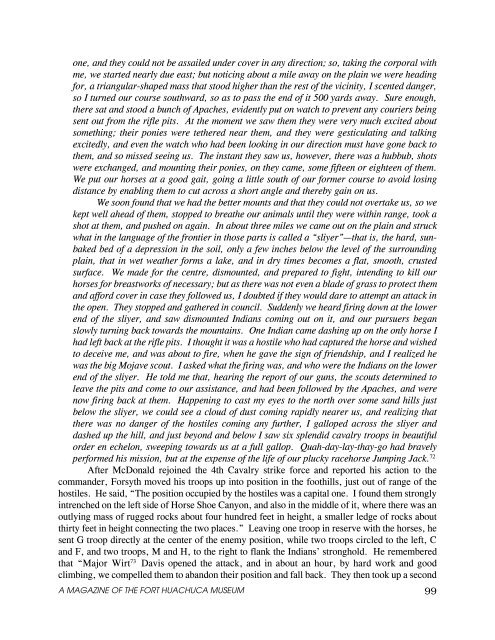Apache Campaigns - Fort Huachuca - U.S. Army
Apache Campaigns - Fort Huachuca - U.S. Army
Apache Campaigns - Fort Huachuca - U.S. Army
Create successful ePaper yourself
Turn your PDF publications into a flip-book with our unique Google optimized e-Paper software.
one, and they could not be assailed under cover in any direction; so, taking the corporal with<br />
me, we started nearly due east; but noticing about a mile away on the plain we were heading<br />
for, a triangular-shaped mass that stood higher than the rest of the vicinity, I scented danger,<br />
so I turned our course southward, so as to pass the end of it 500 yards away. Sure enough,<br />
there sat and stood a bunch of <strong>Apache</strong>s, evidently put on watch to prevent any couriers being<br />
sent out from the rifle pits. At the moment we saw them they were very much excited about<br />
something; their ponies were tethered near them, and they were gesticulating and talking<br />
excitedly, and even the watch who had been looking in our direction must have gone back to<br />
them, and so missed seeing us. The instant they saw us, however, there was a hubbub, shots<br />
were exchanged, and mounting their ponies, on they came, some fifteen or eighteen of them.<br />
We put our horses at a good gait, going a little south of our former course to avoid losing<br />
distance by enabling them to cut across a short angle and thereby gain on us.<br />
We soon found that we had the better mounts and that they could not overtake us, so we<br />
kept well ahead of them, stopped to breathe our animals until they were within range, took a<br />
shot at them, and pushed on again. In about three miles we came out on the plain and struck<br />
what in the language of the frontier in those parts is called a “sliyer”—that is, the hard, sunbaked<br />
bed of a depression in the soil, only a few inches below the level of the surrounding<br />
plain, that in wet weather forms a lake, and in dry times becomes a flat, smooth, crusted<br />
surface. We made for the centre, dismounted, and prepared to fight, intending to kill our<br />
horses for breastworks of necessary; but as there was not even a blade of grass to protect them<br />
and afford cover in case they followed us, I doubted if they would dare to attempt an attack in<br />
the open. They stopped and gathered in council. Suddenly we heard firing down at the lower<br />
end of the sliyer, and saw dismounted Indians coming out on it, and our pursuers began<br />
slowly turning back towards the mountains. One Indian came dashing up on the only horse I<br />
had left back at the rifle pits. I thought it was a hostile who had captured the horse and wished<br />
to deceive me, and was about to fire, when he gave the sign of friendship, and I realized he<br />
was the big Mojave scout. I asked what the firing was, and who were the Indians on the lower<br />
end of the sliyer. He told me that, hearing the report of our guns, the scouts determined to<br />
leave the pits and come to our assistance, and had been followed by the <strong>Apache</strong>s, and were<br />
now firing back at them. Happening to cast my eyes to the north over some sand hills just<br />
below the sliyer, we could see a cloud of dust coming rapidly nearer us, and realizing that<br />
there was no danger of the hostiles coming any further, I galloped across the sliyer and<br />
dashed up the hill, and just beyond and below I saw six splendid cavalry troops in beautiful<br />
order en echelon, sweeping towards us at a full gallop. Quah-day-lay-thay-go had bravely<br />
performed his mission, but at the expense of the life of our plucky racehorse Jumping Jack. 72<br />
After McDonald rejoined the 4th Cavalry strike force and reported his action to the<br />
commander, Forsyth moved his troops up into position in the foothills, just out of range of the<br />
hostiles. He said, “The position occupied by the hostiles was a capital one. I found them strongly<br />
intrenched on the left side of Horse Shoe Canyon, and also in the middle of it, where there was an<br />
outlying mass of rugged rocks about four hundred feet in height, a smaller ledge of rocks about<br />
thirty feet in height connecting the two places.” Leaving one troop in reserve with the horses, he<br />
sent G troop directly at the center of the enemy position, while two troops circled to the left, C<br />
and F, and two troops, M and H, to the right to flank the Indians’ stronghold. He remembered<br />
that “Major Wirt 73 Davis opened the attack, and in about an hour, by hard work and good<br />
climbing, we compelled them to abandon their position and fall back. They then took up a second<br />
A MAGAZINE OF THE FORT HUACHUCA MUSEUM<br />
99

















